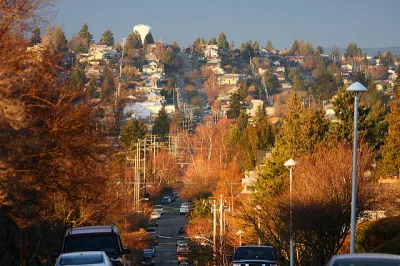"[P]erhaps at this point, this column should include a trigger warning for any young couple traumatized by the current housing market around here."

Gene Balk writes a column about the changes in the Seattle real estate market in terms of what money can buy.
This is not a happy story for many professional, middle-class residents of the city. "It’s hard to believe there was a time, and not really that long ago, when journalists — or teachers, or nurses — could go house hunting in the city of Seattle and actually buy something," writes Balk.
Even adjusting for inflation, the prices of homes in the final decades of the 20th century were far more attainable. For instance, "Census data shows that the median home value in King County in 1980 was $71,400, which, in today’s dollars, is about $225,000. That’s well below half of what it is now," reports Balk.
Balk's presentation of this information is underwritten by the implications of generational conflict. "How much less did boomers pay for their Seattle homes?" asks one of the infographics in the story (and the headline, for that matter).
To even the scales a little, Balk offers a few data points in defense of baby boomers:
…for a lot of folks back then, it didn’t seem so cheap. Keep in mind that King County home values in 1980 were about 50% higher than the U.S. median.
Another mitigating factor: Mortgage interest rates were much higher in the past, particularly in the early 1980s, when they peaked at around 16%. They didn’t fall back down into the single digits until the early 1990s.
There have always been members of the middle class cut out of the homeownership market, according to the implication of that data. Still, Balk expresses sympathy for the many among that number in 2019.
FULL STORY: How much easier was it for baby boomers to buy a home in Seattle? Let’s adjust for inflation

Analysis: Cybertruck Fatality Rate Far Exceeds That of Ford Pinto
The Tesla Cybertruck was recalled seven times last year.

National Parks Layoffs Will Cause Communities to Lose Billions
Thousands of essential park workers were laid off this week, just before the busy spring break season.

Retro-silient?: America’s First “Eco-burb,” The Woodlands Turns 50
A master-planned community north of Houston offers lessons on green infrastructure and resilient design, but falls short of its founder’s lofty affordability and walkability goals.

Test News Post 1
This is a summary

Analysis: Cybertruck Fatality Rate Far Exceeds That of Ford Pinto
The Tesla Cybertruck was recalled seven times last year.

Test News Headline 46
Test for the image on the front page.
Urban Design for Planners 1: Software Tools
This six-course series explores essential urban design concepts using open source software and equips planners with the tools they need to participate fully in the urban design process.
Planning for Universal Design
Learn the tools for implementing Universal Design in planning regulations.
EMC Planning Group, Inc.
Planetizen
Planetizen
Mpact (formerly Rail~Volution)
Great Falls Development Authority, Inc.
HUDs Office of Policy Development and Research
NYU Wagner Graduate School of Public Service




























